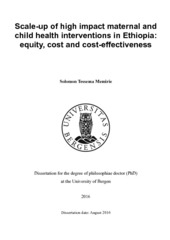Scale-up of high impact maternal and child health interventions in Ethiopia: equity, cost and cost-effectiveness analyses
Doctoral thesis
Permanent lenke
https://hdl.handle.net/1956/15289Utgivelsesdato
2016-08-29Metadata
Vis full innførselSamlinger
Sammendrag
Background: Equity in access to health care services and in health outcome, and safeguarding households from catastrophic and impoverishing medical expenditures are key health systems objectives. However, in low-income countries, studies are lacking that systematically monitor and evaluate health policies with regard to their effect on health inequalities and medical impoverishment. Furthermore, context specific evidence on the cost-effectiveness of interventions is meager. We aim to generate policy relevant evidence on equity, cost and cost-effectiveness of health interventions in order to facilitate priority setting of health interventions in Ethiopia. Methods: This thesis is based on three studies conducted in Ethiopia. The first study used secondary data from successive demographic health surveys to examine inequalities in maternal and child health (MCH) services in Ethiopia. In the second study, we examined household out-of-pocket (OOP) expenses and impoverishment associated with health care visits for pneumonia and diarrhea in Ethiopia. Data on OOP expenses were collected through exit and follow-up interviews of families who sought care in health facilities. The third study was a contextualized costeffectiveness analysis (CEA) of maternal and neonatal health interventions scale up in Ethiopia using the World Health Organization’s CHOosing Interventions that are Cost-Effective (CHOICE) maternal and neonatal health model. Results: Between 2005 and 2011, improvements in aggregate coverage have been observed for MCH interventions in Ethiopia. Wealth-related inequality has remained persistently high in all surveys. Socioeconomic factors were the main predictors of differences in MCH services utilization and child health outcome. Utilization of primary care facilities for selected MCH interventions have shown marked pro-poor improvement over the period 2005-2011. The study on OOP expenses included 345 pneumonia and 341 diarrhea cases. The mean total medical expenditures (in 2013$USD) per outpatient visit were USD 8 for pneumonia and USD 6 for diarrhea while per inpatient care were USD 64 for severe pneumonia and USD 79 for severe diarrhea. The mean associated direct non-medical expenses (mainly transport costs) were USD 2, USD 2, USD 13, and USD 20 respectively. 7% and 6% of the households with a case of severe pneumonia and severe diarrhea respectively were pushed below the extreme poverty threshold of PPP USD 1.25 a day. Wealthier and urban households had higher OOP payments but poorer and rural households were more likely to be impoverished due to medical payments. The CEA showed that all interventions except calcium supplementation (for preeclampsia and eclampsia preventions) were very cost effective with incremental cost effectiveness ratios less than one times GDP per capita. Interventions for newborn care were highly cost-effective (e.g. Kangaroo mother care, neonatal resuscitation, newborn sepsis management, antibiotics for preterm prelabor rupture of membranes) followed by selected antenatal interventions (e.g. tetanus toxoid and syphilis diagnosis and treatment for pregnant women), then followed by more complex interventions that require care at secondary/tertiary level facilities. Delivery of interventions within packages was more cost-effective than delivering single interventions. Conclusions: Attainment of universal health coverage (UHC) through delivery of quality essential health services package using primary health care (PHC) as the delivery platform is one of the key strategic objectives of the health sector transformation plan for the next five years (2015/2016 – 2019/2020) in Ethiopia. The results of these studies could be used to repopulate the essential health care package in Ethiopia.
Består av
Paper I: Memirie ST, Verguet S, Norheim OF, Levin C, Johansson KJ. Inequalities in Utilization of Maternal and Child health services in Ethiopia: the role of primary health care. BMC Health Service Research 2016; 16:51. The article is available at: http://hdl.handle.net/1956/12924Paper II: Memirie ST, Metaferia ZS, Norheim OF, Levin C, Verguet S, Johansson KJ. Household expenditures on pneumonia and diarrhea treatment in Ethiopia: a facility-based study. BMJ Global Health. 2017;1:e000166. The article is available at: http://hdl.handle.net/1956/17525
Paper III: Memirie ST, Bertram M, Desalegn D, Hailemariam M, Strand KB, Tadesse M, Norheim OF, Verguet S, Johansson KJ. Scaling up maternal and neonatal health interventions in Ethiopia: a cost-effectiveness analysis. Full text not available in BORA.
